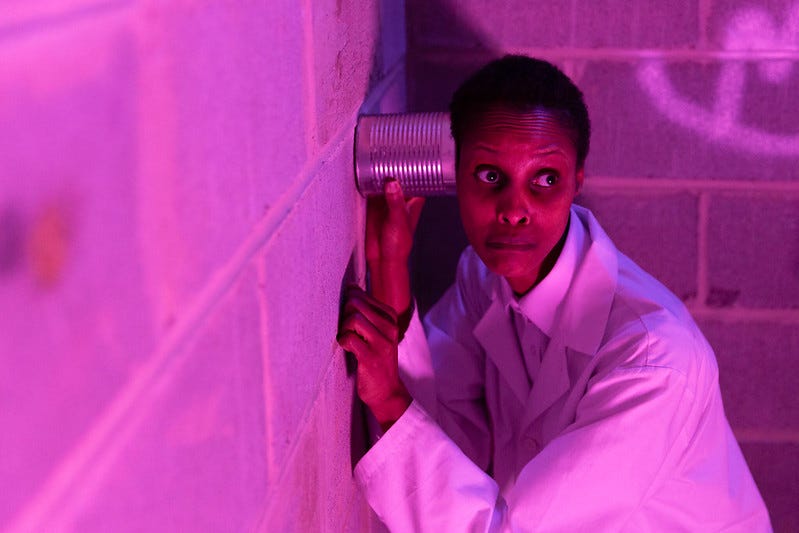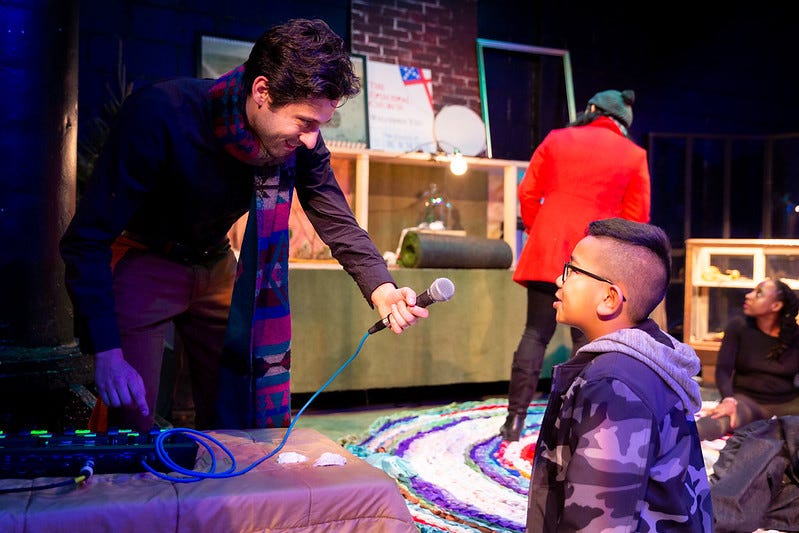The Jane Jacobs-Inspired UP CLOSE Festival Brings Kids ‘Close’ to the Action (Review)
Family-friendly immersive theatre finds its way in the West Village


“Listen closely, can you hear that?” the man in the white lab coat asks me, his ear pressed to a silver tin can against the bookshelf.
He beckons me to take a listen, which I do.
“I think it’s…waves?” I respond.
He takes the tin can and is off in a flash, sharing the new sound with other audience members surrounding the shelves full of captured sounds. This was the first of many fleeting moments of wonder that would soon activate the surrounding space.

The UP CLOSE Festival is a family friendly project centered around immersive works. Presenting for their second year at the New Ohio Theatre, the festival is focused on telling stories about New York City and all the inherent history surrounding us city dwellers in our day to day. Created by Peter Musante and associate produced by Sara Morgulis, the event takes inspiration from legendary West Village artist Jane Jacobs by creating a “living archive” in order to engage younger theatregoers in the history of the world that surrounds them. The performance is comprised of a free form pre-show, allowing the audience to explore what will soon become the sets of the performances, followed by three short immersive and participatory pieces. This year’s lineup includes Sanctuary/Garden by Spellbound Theatre, a look into the history of St. Luke in the Fields community garden, 219 Thompson St. created by Marisa Blankier and Christopher-Rashee Simpson, which is a quick lesson on the history of the famed West Village chess wars, and The Society of Historic Sonic Happenings (SHSH) by Adrienne Kapstein, a sensory based investigation of the preservation of sound throughout history.
Get Allie Marotta’s stories in your inbox
Join Medium for free to get updates from this writer.
SubscribeSubscribe
The first piece, Sanctuary/Garden, uses St. Luke in the Fields’ community garden, a location mere steps away from the theatre, as its inspiration. Children sit on a large woven rug and settle in for a new kind of storytime through this educational piece that takes the audience through a large span of time. Performers tell us about the history of the area while using props like branches, oyster shells, and leaves to engage the tiny hands surrounding them on the carpet. We learn about the trees that lived in the garden long before our time all the way up to a family friendly recognition of the church’s role in the AIDS crisis in the ’80s. We sip on tea made from peppermint harvested from the garden and discuss with those around us what we can do to help take care of someone when they’re not feeling well. After sharing our responses with the room, the performers soon look sharply over to the area behind us and freeze. The lights change and stewards gently direct us to the next piece which takes place on the risers just behind us.

219 Thompson St. uses chess as a way into the history of New York City, detailing the chess wars, or The Civil War on Thompson St., which took place in the West Village in the ’90s. Imad Khachan went to battle with his former business partner when a disagreement caused him to open his own shop, The Chess Forum, across the street from their formerly shared business, The Chess Shop. This piece investigates the rift in the chess community, using the risers as a clever way to divide space into many locations like the chess shops and a nearby bodega. The piece concludes in a live demo of how each of the game pieces work, using audience members chosen during the pre-show who wear cloth hats in the shape of each chess piece and move accordingly on a life-sized chess board painted on the floor.
Last but not least, the audience is introduced to The Society of Historic Sonic Happenings (SHSH). SHSH is an imagined wing of Bell Laboratories, developed to capture and preserve all the sounds of the past. Sounds are captured in special jars that keep the noise from escaping, so long as you don’t open the lid. Forgotten sounds can even be heard by holding a SHSH jar close to your ear, or if you’re lucky you might find a sound in the wild by using one of the SHSH scientists’ high tech tin can instruments to listen. The SHSH scientists explain their research and even pass around a few captured sounds for the audience to listen to, but soon it’s time to split up and search for new sounds. The audience divides up into teams and departs to find new sounds with one of the SHSH scientists. Each team has the opportunity to capture up to three sounds before a strange, sonic rumbling begins. At once, everyone gathers to investigate and we find that the next sound to be captured is that of our own voices, locking our time at SHSH in history forever.

I had a blast at UP CLOSE, but I actually wouldn’t recommend it for the average immersive theatre-goer, especially if you’re not a “kid person.” The festival markets itself as being fun for all ages, but the focus is definitely on the kids. Children are brought closest to the action and engaged with constantly, while grown-ups are not, which is fair considering the pieces are designed for young viewers. But I definitely felt a bit out of place being there by myself without a child, and the pieces are definitely based in typical theatre for young audiences (TYA) practices (with the exception of SHSH, which with development I would argue could stand on its own as an immersive and participatory piece) so overall it was a bit strange. What does work is that the whole event is so well-crafted for kids; every child in that room was wholeheartedly engaged and having fun and the performers are all well-prepared to adjust for the unpredictableness of a child heavy audience. However, from what I saw the festival is not entirely sensory friendly, so kiddos with sensitivities to crowded spaces, loud noises, and changing lights might have a difficult time enjoying the event as a whole.
All three pieces in UP CLOSE were delightful, but as a teaching artist I found myself recognizing engagement techniques I often use in the classroom in the construction of Sanctuary/Garden and 219 Thompson St., particularly concerning the participatory aspects of both, which pulled away from the idea of it being a performance. The Society of Historic Sonic Happenings was by far the standout performance of UP CLOSE for me, and what sets it apart is that the experience is able to access the audience and engage young viewers in a way that felt effortlessly incorporated into the performance itself, whereas the others felt a bit like theatre classes for kids. Despite some of the growing pains, at the end of the day I was really pleased to see an event like this crafted with kids in mind. Immersive practices are a fantastic tool for TYA projects and have a unique way of making kids feel comfortable in a theatre setting. The recognition of audience as something other than solely spectator opens a world of accessibility for kids who might feel intimidated by such a “serious” form. With the rising success of theatre as a vehicle for learning in schools, events like the UP CLOSE Festival are an exciting development in the growing field.
UP CLOSE has concluded.
NoPro is a labor of love made possible by our generous Patreon backers. Join them today!
In addition to the No Proscenium web site, our podcast, and our newsletters, you can find NoPro on Twitter, Facebook, YouTube, Instagram, in the Facebook community Everything Immersive, and on our Slack forum.
Office facilities provided by Thymele Arts, in Los Angeles, CA.